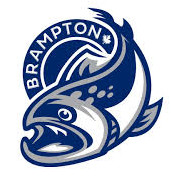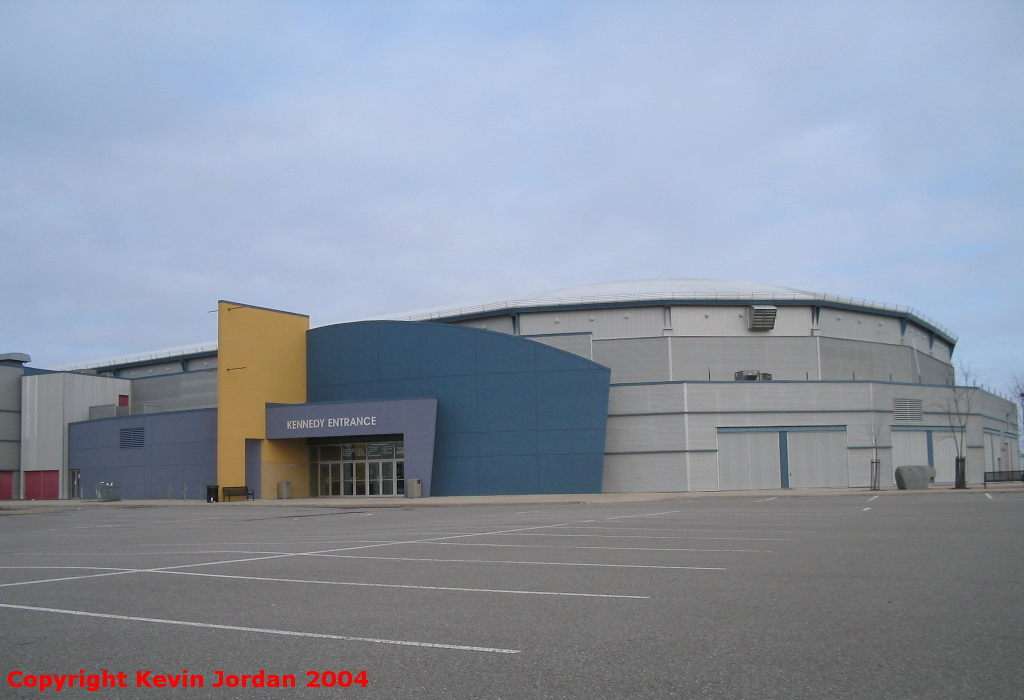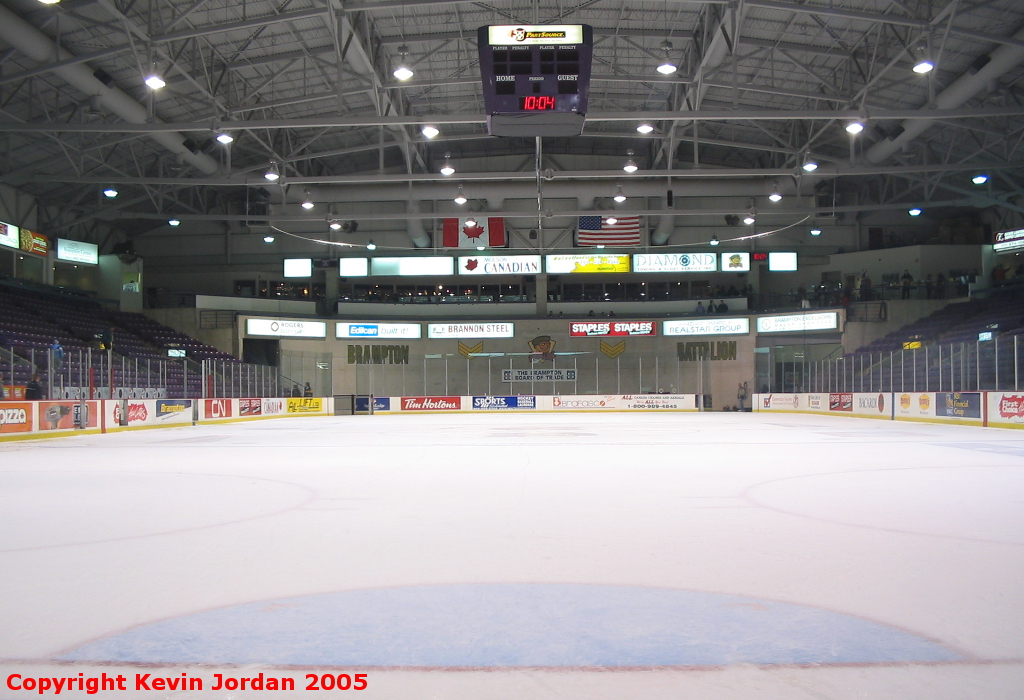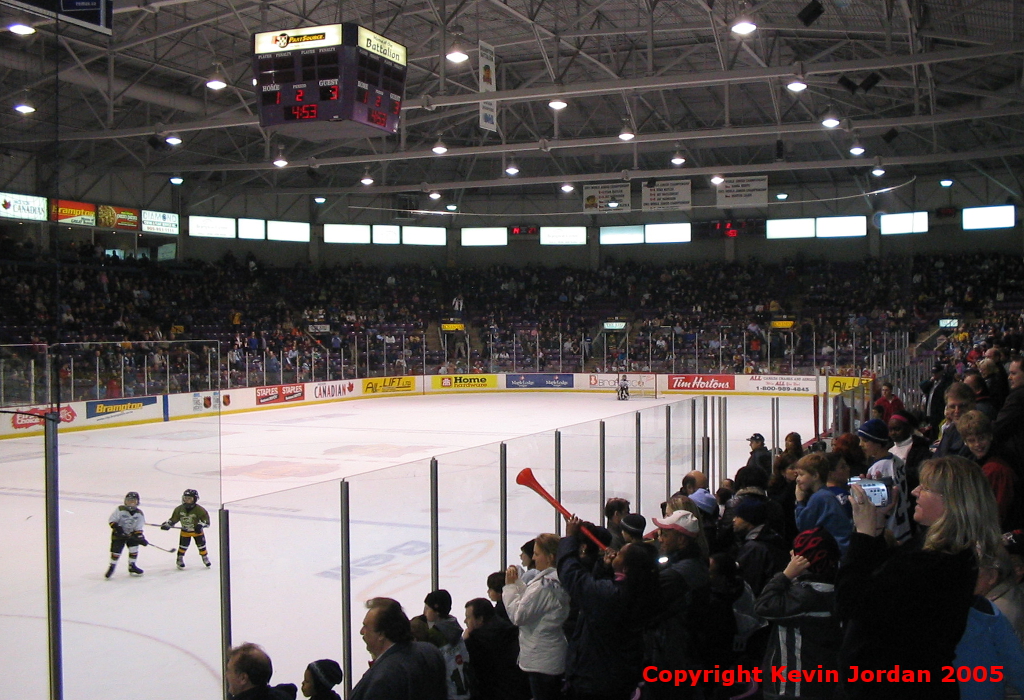
Brampton Steelheads
Arena Name: CAA Centre
Capacity: 4,959 (4,774 seated)
Built: 1998
Address: 7575 Kennedy Rd. South, Brampton, ON, L6W 4T2
Ice Surface Size: Regulation
Franchise Date: 2007-08
OHL Championships: None
Memorial Cup Championships: None
Colours: Blue, Silver & White
Official Web Site: BramptonSteelheads.com
Venue Web Site: CAACentre.com
Former Arenas: Paramount Centre, Maple Leaf Gardens,
St. Michael's College Arena, Air Canada Centre

CAA Centre

What Was the Arena Like?
First Visit: November 23, 2003
CHL Arena: 13
OHL Arena: 13
The OHL expanded to Mississauga and Brampton together in 1998, placing the closest two teams in the history of the CHL (that weren't building-sharing) a mere six kilometres apart on the same street. Unless the western frontier of the Greater Toronto Area held vast untapped reserves of junior hockey fans, the venture was doomed from the start, as anyone at the time could have told you. So how did this even happen?
As the OHL was preparing to expand to Brampton, nearby Mississauga offered a sweetheart arena deal and money and the publicity promised by the legendary Don Cherry as part of the ownership group, so expansion was granted to Mississauga at the same time. Such was the OHL handicapped at the very beginning of its existence in Halton-Peel region. Instead of one community team with over a million people to advertise and cater towards, you had two - acting as rivals, hating each other, and competing for the attention of the same fickle, Leafs-loving suburban Torontonian fan. The Battalion's withdrawal in 2013, moving north to the old outpost of North Bay, was a confirmation that the league's "Toronto Strategy" had been a dismal failure.
Oh, and in that time, the IceDogs had also left for Niagara, replaced by what had once been the reborn Toronto St. Michael's Majors at the Hershey Centre. The team kept the Majors name in Mississauga until 2012, when new ownership went for a complete rebranding and adopted the Leafs uniform template (of course they did) and renamed the team the Steelheads. Brampton, meanwhile, had a go of it in the Central League and the ECHL, but the pro game didn't sell any better than junior had, and once they left the building sat largely unused for a lot of the time.
At the end of the 2023-24 season, the powers that ran what was now called the Paramount Centre in Mississauga informed the team that, owing to the success of Raptors 905 and a growing calendar of other events in Halton Region, the facility was not interested in renewing the Steelheads' lease. It is almost unheard of to pass up a guaranteed 30+ dates a year on an event calendar, so this was extraordinary, but one can understand why it wasn't worth the facility's effort. Meanwhile, the city of Brampton had been losing money on a mostly-empty event centre and was willing to offer a sweetheart deal on the lease, so, with the team wanting to stay in the region and with no other options on the table, the Brampton Centre was, improbably, once again an OHL building in the fall of 2024.
From the outside the CAA Centre looks like a hockey arena but is unusually clad in reflective corrugated steel, which makes the arena glow on a sunny day. When the rink was new, it didn't look half bad, but in 2025, the ravages of road salt in Canadian winters have meant the building has a lot of rust damage around the foot of the walls, where the structure meets the ground. The arena is a ovoid oblong structure with a massive box attached, which contains three community rinks. The CAA Centre doubles as a community arena and there are four ice surfaces in the building along with requisite dressing rooms and the like. The main part of the building, though, has two main entrances - one on each side - and entering the building feels like entering an older rink. The concourses are about as bare-bones as newer arenas get, with bland whitewash and grey paint and only a handful of the most basic concessions available. I distinctly recall the Battalion having a proper team store within the arena, but the Steelheads make use with two makeshift pop-up souvenir stands in the concourse. The concourse is also home to the Brampton Sports Hall of Fame, which is worth investigating in an intermission.
Inside the bowl, the seats are laid out in a "U" shape and every single one is a peevishly bright purple. Ugh. They're also narrow for a new building, and leg room, while great compared with some of the league, isn't fantastic for a newer building. In fact, perhaps the best word to describe the CAA Centre would be "spartan". There are luxury boxes running down both sides of the building but many of them are usually empty on gamedays.
The views from the seats are universally good. The fourth side of the building, or the space at the top of the "U", used to feature a restaurant above and bleachers below, but for the Steelheads it seems like just a lot of dead space. Battalion logos were once painted on the wall behind the bleachers, but now it's just barren concrete. The scoreboard was once the last in the OHL not to feature a video screen, but that obviously has been upgraded now; about the only upgrade the building has seen since 1998. The scoreboard, oddly, has the same corrugated steel as the building's exterior, which is a clever, if weird, touch.
Perhaps the worst feature at the CAA Centre comes from the fact that it was thrown up in a hurry in a little-developed area. There is only one way to get to the building - by car - and while the Centre has a massive free parking lot, there are only two small entrances to the lot from Kennedy Road, which itself used to be only two lanes outside the building, but at least now there's four lanes and a traffic light. As a result, traffic backups in Brampton are legendary, and even with the team's traditional small crowds, it can take anywhere from ten minutes to a half-hour to get out of the parking lot after the game. Unlike nearly every other sporting facility in Canada, leaving early to beat the rush in Brampton actually makes sense.
The Battalion branding used to be about the only unique thing in Brampton, between the military theme, Edwin Starr, and those love-them-or-hate-them uniforms. Going to a Steelheads game, in comparison, feels like seeing 'Create A Team' in a video game come to life. There are no team colours, no branding, no signs whatsoever in the building that the team is planning to stay long-term. No one would blame them if they were not, of course, and that might be something that changes given a full off-season to prepare, but for now it's about as bland and generic a hockey experience as North America offers. That the team might not be here forever is even visible in some of the accoutrements, like the shoulder patches that still feature a big "M" and the Port Credit lighthouse, or the mascot, a big fish still named Sauga. (Less catchy than 'Pton', maybe?) The logo wordmark changed from Mississauga to Brampton, but otherwise the entire project has the feel of an owner who wanted to spend the least amount of money possible to rebrand.
Finally, I would be remiss if I didn't mention the old signs of impending doom in Brampton, like unsold advertising space including one unbranded ice resurfacer. And besides, the arena, from having had so little reason to do anything with it for so long, now feels like it's rapidly aging. The whole place feels like it needs a coat of paint and a good cleaning, and nearly all the signs of any progress in arena design since the 1990's, like ribbon boards, a range of food and beverage options, clever promotions, and a decent team store, are all missing. This isn't Spokane's lovingly-maintained 1990's design museum, either; this is a rink that hasn't had anyone care about it in a very long time.
Where once the GTA had four OHL teams, today there are two - the Steelheads in the west and the Oshawa Generals in the east. Two formerly unserved markets in North Bay and the Niagara region now have teams instead, and the OHL is far stronger for it. The Steelheads are still on life support, and no one in hockey circles seriously thinks it's going to work out long-term for them in Peel Region, but they just might get there if the former Battalion, IceDogs and Majors fans finally bury the hatchet and start supporting the one team they have left. I am not holding my breath.
Inside the CAA Centre

Future Developments
The CAA Centre had some minor refurbishment in anticipation of the Steelheads' arrival, but there are no plans at this time for major renovations.
Franchise History
The St. Michael's Majors were originally founded in 1906, but the school dropped out of the OHL in 1961. From what was once the Majors' website: "In 1961, hockey at St. Mike's was riding high. The Majors had just won their fourth Memorial Cup; more than any other team at the time. The Buzzers had followed up with another O.H.A. Junior "B" crown. The new St. Michael's Arena promised to fulfill the vision of 'hockey for every boy at St. Michael's'.
"However, education always has been and always will be the focus at St. Michael's College School. It had become painfully apparent to Father Bauer that the goals of Major Junior hockey at the time were no longer compatible with the educational needs of his students. Within weeks of St. Michael's Memorial Cup win, Father Bauer decided that the Majors should withdraw from the league. Major Junior hockey would be absent from St. Michael's for the next 36 years."
The current Majors were added to the OHL as an expansion team in 1997-98. The new Majors played out of Maple Leaf Gardens originally, but moved into the St. Michael's College School Arena when MLG closed. The move to the tiny College rink was supposed to be temporary, but lasted for much longer than it should have as owner Eugene Melnyk tried in vain to build a new arena complex in Toronto independently of Maple Leaf Sports and Global Domination. In 2006 Melnyk bought the Mississauga IceDogs from then-owner Mario Forgione, and ran that team as a lame-duck for one season before selling them to printing executive Bill Burke, who moved them to St. Catharines. The move was made so that the Majors could take over the IceDogs' lease at the Hershey Centre, and so in the end, the Majors got their arena and the Niagara region got a team back for the first time in a decade.
In 2012, another new ownership group finally broke from the College again and renamed the team from Majors to Steelheads. The team played at the Paramount Centre until the end of the 2023-24 season, at which point the building evicted them. With no other options in the GTA, the Steelheads moved 6 km up the road and made the CAA Centre an OHL building once again.
"However, education always has been and always will be the focus at St. Michael's College School. It had become painfully apparent to Father Bauer that the goals of Major Junior hockey at the time were no longer compatible with the educational needs of his students. Within weeks of St. Michael's Memorial Cup win, Father Bauer decided that the Majors should withdraw from the league. Major Junior hockey would be absent from St. Michael's for the next 36 years."
The current Majors were added to the OHL as an expansion team in 1997-98. The new Majors played out of Maple Leaf Gardens originally, but moved into the St. Michael's College School Arena when MLG closed. The move to the tiny College rink was supposed to be temporary, but lasted for much longer than it should have as owner Eugene Melnyk tried in vain to build a new arena complex in Toronto independently of Maple Leaf Sports and Global Domination. In 2006 Melnyk bought the Mississauga IceDogs from then-owner Mario Forgione, and ran that team as a lame-duck for one season before selling them to printing executive Bill Burke, who moved them to St. Catharines. The move was made so that the Majors could take over the IceDogs' lease at the Hershey Centre, and so in the end, the Majors got their arena and the Niagara region got a team back for the first time in a decade.
In 2012, another new ownership group finally broke from the College again and renamed the team from Majors to Steelheads. The team played at the Paramount Centre until the end of the 2023-24 season, at which point the building evicted them. With no other options in the GTA, the Steelheads moved 6 km up the road and made the CAA Centre an OHL building once again.
Inside the CAA Centre

Retired Numbers
None
Feedback
If anything is incorrect or you have something to add, please e-mail me at  and I'll update the guide.
and I'll update the guide.
 and I'll update the guide.
and I'll update the guide.Copyright © OHL Arena Guide, 2002-25.
All rights reserved.
Last Revised: February 9, 2025